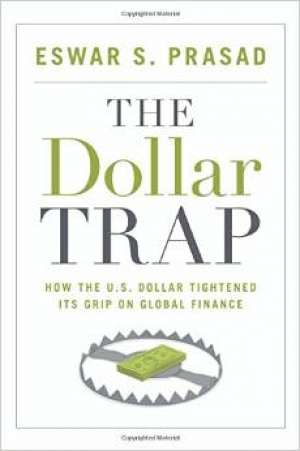12 October 2014
The Dollar Trap
How the U.S. Dollar Tightened Its Grip on Global Finance
Eswar S. Prasad
2014, Princeton University Press, 432 pages, £24.95
ISBN 9780691161129
Reviewer: Ian Harwood, Redburn

Mark Twain’s famous riposte that, “Reports of my death have been greatly exaggerated,” could equally well be applied to the fate of the US dollar during the course of the past few decades. The dollar, having been constituted the linchpin of the post-war internal monetary system until the US government abandoned a fixed parity in the early 1970s, the US currency’s future has since frequently been subject to apocalyptic predictions of impending collapse.
Such predictions have had much in common with a medieval morality play, with the US currency assured to suffer retribution as a consequence of the US population living chronically beyond its means, with neither the government (during the 1970s, 1980s and the post-financial crisis period) nor the US private sector (from the mid-1990s to the bubble economy’s denouement in 2008/09) demonstrably able or willing to curb their baser spending enthusiasms.
Furthermore, the ensuing dollar collapse – the result of foreigners refusing any longer to finance the US external deficit and, instead, precipitately withdrawing their funds – was generally expected to result in a exceptionally nasty hard landing for the US economy, with all the adverse knock-on effects a collapse of domestic demand in the world’s largest importer implied for the rest of the world.
In the event, of course, the US dollar has suffered no such disorderly decline. Certainly, it has lost substantial external value over time, with successive US administrations tending to pursue a policy of benign neglect. As US Treasury Secretary Connolly observed so presciently back in 1971, “The dollar may be our currency but it’s your problem.”
Significantly though, this progressive loss of value – which hasn’t proceeded in a straight line but has, instead, been punctuated by periodic rallies – has not resulted in any noticeable difficulty in attracting continuing inflows of foreign capital. At no time has this been more apparent than during the recent, post-financial crisis years, despite the US government running record deficits, accumulating ever-rising levels of debt and the US central bank having resorted to successive episodes of large-scale money printing.
This recent US currency resilience constitutes the starting point for Prasad’s excellent book, his central argument being that the world is at present caught in a ‘dollar trap’. In a world beset by acute uncertainty, demand in the rest of the world for dollar-denominated assets remains high. In part this is attributable to the size and strength of the US economy, coupled with the size and depth of its financial markets. As Prasad so rightly emphasises, however, much of this appetite for US assets is driven by confidence in US political stability and institutions (Washington’s recent dysfunctionality notwithstanding), with respect for the rule of law especially important in this respect. Looking ahead, Prasad’s assessment of possible reserve currency alternatives to the dollar – whether the euro, renminbi, gold or bitcoin – is excellent.
Overall, Prasad’s book is an exceptionally interesting one, and can be recommended to anybody who is seeking better to understand the dollar’s unique role within the global economy, in the context of a wide-ranging and comprehensive historical assessment. Importantly, too, the book, though lengthy, is very readable. It wears its (clearly immense) learning lightly and is extremely well-written. I recommend it highly.
